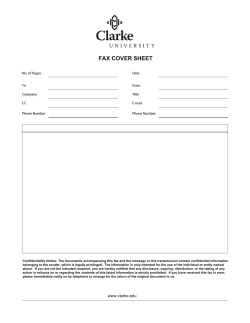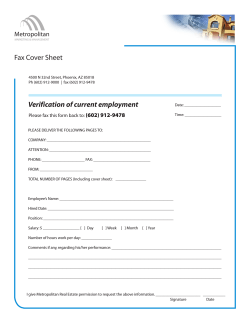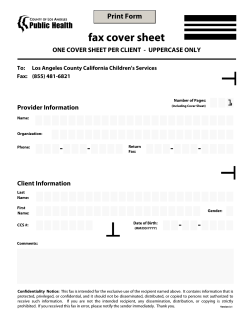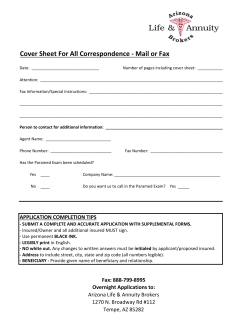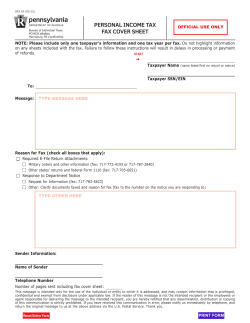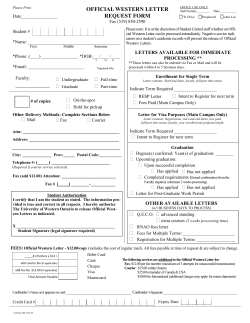
: Modification of AOAC Official Method 998.12 to... Study of Proposed Method Modification to AOAC 998.12 Filtration and/or Centrifugation
Study of Proposed Method Modification to AOAC 998.12 1. Study Title: Modification of AOAC Official Method 998.12 to add Filtration and/or Centrifugation 2. Study Directors / Participating Laboratories 1. Co-Study Director Dana Krueger Krueger Food Laboratories, Inc. 45 Manning Road Billerica MA 01821 Phone: 978-667-6900 Fax: 978-667-6999 dkrueger@kfl.com 2. Co-Study Director Dr Karyne Rogers National Isotope Centre GNS Science PO Box 31-312 Lower Hutt, New Zealand Phone: +64 4 570 4636 Fax: +64 4 570 4657 k.rogers@gns.cri.nz 3. Co-Study Director Klaus Beckmann Quality Services International GmbH Flughafendamm 9a 28199 Bremen, Germany Phone: +49 - (0)421 - 59 47 70 Fax: +49 - (0)421 - 59 47 71 E-Mail: info@qsi-q3.de 4. Test Material and Study Coordinator Jo Marie Cook Florida Department of Agriculture and Consumer Services 3125 Conner Blvd,, Bldg #3 Tallahassee, FL, 32399-1650 USA Phone: 850-617-7505 Fax: 850-922-9110 jomarie.cook@freshfromflorida.com -1- Study Description 1. Principle: Method 998.12 determines the presence of C-4 (corn or cane sugars) in honey by comparing the carbon isotopic value of whole honey with its internal protein. The method may falsely indicate the presence of C-4 sugars in certain honeys such as New Zealand Manuka honey due to high pollen content which is extracted with the protein. Centrifugation and/or filtration are proposed as modifications to the method to assure accurate determination of C-4 sugars. 2. Scope and Applicability: This method is applicable to the measurement of C-4 (corn and cane) sugars in honey at a concentration >7% 3. Test Materials/matrices: Four pure honeys and one adulterated honey: U.S. honey which has passed the 998.12 C-4 test German honey which have passed the 998.12 C-4 test two New Zealand Manuka varieties which have failed the 998.12 C-4 test one U.S. honey adulterated with 15% corn syrup. 4. Test sample preparation and handling: Honeys will be provided by laboratories 1, 2 and 3. Identical test tubes will be provided to each of the contributing laboratories. The laboratories will fill each of 65 tubes with 30 – 35 gm of honey; seal with cap and teflon tape and ship to laboratory 4. Providing laboratories will assure homogeneity by conducting homogeneity studies before shipping their samples. Laboratory 4 will label and randomly number the test samples and ship them to all the collaborating laboratories. Samples will be shipped in insulated containers by expedited air transport to collaborator locations so as to arrive during the standard work week. The collaborating laboratories will pay for test material shipment. 5. Collaborative Study Design: The study will be conducted on five matrices as blind duplicates. Three sets of separately blinded duplicates will be provided, one for analysis by 998.12 as written (10 test samples), one for analysis with the addition of filtration (10 test samples) and one with the addition of centrifugation and filtration (10 test samples) for a total of 30 test samples. Random identification numbers will be assigned to each of the blind duplicate materials. Laboratories will be asked to analyze the samples as described in 998.12 with only the modifications described in Appendix A. Only laboratories experienced in analysis using 998.12 will participate so no practice samples are necessary. Method: See Appendix A for description of the method modifications to be followed. A copy of 998.12 is also attached. Collaborators: See Appendix B for listing of Collaborators. Reporting Raw Data: Four data points are to be reported for each material: 1. Average δ13C value (‰) Whole Honey 2. Average δ13C value (‰) Protein Extract 3. Difference (Honey – Protein Extract) (‰) -2- 4. %C4 Sugars Collaborators will be asked to supply any modification made to 998.12 other than those specified in Appendix A. Excel data reporting sheets will be emailed to the collaborators. (see Appendix C). All results will be sent to laboratory 4 who will provide the key to the randomized test materials and submit the results to the co-study directors, laboratories 1,2 and 3. The study directors will evaluate the data, generate tables from the raw data received and prepare the Study Report. Analyzing the Raw Data: Descriptions of the blind duplicate matrices will be included with the tables of raw data. Determinations will be made of standard deviations for repeatability (Sr) and reproducibility (SR), relative standard deviations for repeatability (RSDr) and reproducibility (RSDR), number of statistical outlier laboratories, and HORRAT value (RSDR/predicted RSDR) if applicable. Cochran and Grubbs tests will be used to determine outliers. Miscellani: Additional appendices contain a letter with instructions to participants (Appendix D), and a study materials receipt form (Appendix E). -3- Appendix A: Test 1. Unfiltered: Perform method 998.12, using protein preparation method 998.12 C (1) Test 2. Filtered: Perform method 998.12, except substitute for the protein preparation method 998.12 C (1) the following: Dilute honey in water (1:1), warm to 50C and vacuum filter the solution through a paper filter with a mesh size of <10 µm (Macherey & Nagel, MN 617 or equivalent). Continue with protein preparation method 998.12 C (1) starting from “Add 2.0 mL NaWO4 solution…” Test 3. Centrifuged and Filtered: Perform method 998.12, except substitute for the protein preparation method 998.12 C (1) the following: Add 5-10 mL H2O to 10-12 g honey in a 50 mL centrifuge tube. Mix well, heating if necessary to aid dissolution. Centrifuge the sample at 3000 rpm for 5 min to remove fine material such as dust and pollen. Warm the sample to 50C and carefully decant the supernatant to a vacuum filter with glass filter with a mesh size of <10 µm (Whatman GF/C or equivalent) to remove any floating insoluble particulate material such as pollen that was not removed by centrifuging. Continue with protein preparation method 998.12 C (1) starting from “Add 2.0 mL NaWO4 solution…” -4- Appendix B: List of Collaborating Labs 1. Dana Krueger Krueger Food Laboratories, Inc. 21 Alpha Road Chelmsford, MA 01824 Phone: 978-256-1220 Fax: 978-256-1222 dkrueger@kfl.com 2. Dr. Andy Phillips or Nicola Lang National Isotope Centre GNS Science 30 Gracefield Road Graceville, Lower Hutt, 5010 New Zealand Phone: +64 4 570 4878 Fax: +64 4 570 4657 n.lang@gns.cri.nz 3. Klaus Beckmann Quality Services International GmbH Flughafendamm 9a 28199 Bremen, Germany Phone: +49 - (0)421 - 59 47 70 Fax: +49 - (0)421 - 59 47 71 info@qsi-q3.de 4. Jonathan S. Haché, Chemist Ottawa Laboratory (Carling) | Canadian Food Inspection Agency | 960 Carling Ave, Bldg 22 C.E.F, Ottawa, ON K1A 0C6 Jonathan.Hache@inspection.gc.ca Telephone | Téléphone 613-759-1218 Facsimile | Télécopieur 613-759-1260 Government of Canada | Gouvernement du Canada Jonathan.Hache@inspection.gc.ca 5. Dr. Lutz Elflein Head of Laboratory / Certified Food Chemist Tel: +49 (0) 421 65 727 370 Intertek Food Services GmbH Olof-Palme-Str. 8 28719 Bremen, Germany Fax: +49 (0) 421 65 727 222 lutz.elflein@intertek.com www.applica.de or www.intertek.de -5- 6. Mr Wu Bin Food Laboratory Animal Plant and Food Inspection Centre Jiangsu Entry-Exit Inspection and Quarantine Bureau 99 Zhonghua Road Nanjing 210001, China tel 00862552345188 Fax 00862552345183 liuy@jsciq.gov.cn 7. Mr Freddy Thomas (and PT offer) R&D Authenticity Project Manager Eurofins Analytics Rue P.A. Bobierre BP 42301 F-44323 Nantes Cedex 3 FRANCE Phone: +33 2 51 83 21 00 Fax: +33 2 51 83 21 11 FreddyThomas@eurofins.com Web site: www.eurofins.fr 8. Dr. Fabio Fuselli Ministry of agricolture food and forrestal policies Department of Central Inspectorate for Food and Feed Quality protection and Fraud repression Centrale Laboratory of Rome Via del Fornetto 85 00149 - Rome (Italy) Tel. +39 06 55341669 Centr. +39 06 55341641 Fax +39 06 55341691 f.fuselli@mpaaf.gov.it 9. Dott. Perini Matteo Laboratorio chimico e consulenza enologica Sperimentazione agraria, ambientale e forestale Centro Trasferimento Tecnologico Via E. Mach n. 2 Fondazione Edmund Mach 38010 San Michele all'Adige (TN) matteo.perini@iasma.it Tel. 0461615261 Fax. 0461615288 10. Lesley Chesson IsoForensics, Inc. 421 Wakara Way, Suite 100 Salt Lake City, UT 84108 Tel. 801-971-6004 http://isoforensics.com lesley@isoforensics.com isoforensics@mac.com -6- Appendix D. Cover Letter and Instructions to Participants Dear Study Participant, Thank you for participating in the study of modifications to AOAC Method 998.12. Please ensure that the contents of the parcel have not been damaged during transit. Complete the enclosed “Study Materials Receipt Form” and e-mail to Jo Marie Cook at jomarie.cook@freshfromflorida.com. A copy of the study protocol is attached together with a copy of method 998.12 and the two suggested variations (Appendix A). You should receive three sets of samples, 10 tubes each. Analyze Set 1 using 998.12 as performed in your laboratory. Analyze Set 2 using the filtration step before analysis. Analyze set 3 using the centrifugation / filtration step before analysis. Report data using the Excel spreadsheet sent to you via email. There are four sheets to the workbook; an instruction sheet, a sheet to report the unfiltered analyses, a sheet to report Set 2 with filtration and a sheet to report Set 3 with centrifugation. In addition to reporting your test results please enclose a copy of your in-laboratory procedure for the method or a written description of any variations to 998.12 used in your laboratory. Please return the report either by email or regular mail BEFORE March 1, 2012. Your participation in this collaborative study is greatly appreciated. Sincerely, Study Directors -7- Appendix E. Collaborative Study Materials Receipt Form Name of Participant: Please ensure that the items listed below have been received undamaged, insert date of receipt, and circle the relevant statement: Date of the receipt All items have been received undamaged yes/no Items are missing/damaged. yes/no List missing/damaged items needing replacement, if a whole series is not needed: I require an additional series of samples yes/no Contents of parcel a) 30 units of samples (10 samples each for three variations of the method; unfiltered, filtered and centrifuges). b) A copy of the protocol. c) An Excel file for reporting results, provided via email Please e-mail the completed form to: Jo Marie Cook Email: jomarie.cook@freshfromflorida.com Phone: 850-617-7505 -8-
© Copyright 2025

